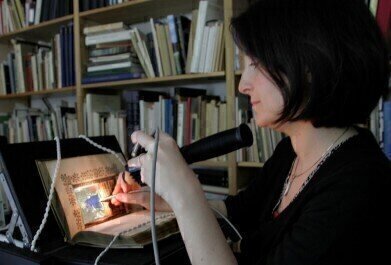Mass Spectrometry & Spectroscopy
Report on Pigment Analysis of Illuminated Manuscripts at the Fitzwilliam Museum
Oct 13 2012
Dr Paola Ricciardi is a research associate in the Department of Manuscripts and Printed Books at the Fitzwilliam Museum in Cambridge. Her work is part of the MINIARE project, focusing on Manuscript Illumination: Non-Invasive Analysis, Research & Expertise. MINIARE is a new interdisciplinary collaboration between the Fitzwilliam Museum and the University of Cambridge's Departments of Chemistry, Physics, Art History and History and Philosophy of Science. It aims at using a combination of advanced scientific methods for the study of illuminated manuscripts, in order to inform interdisciplinary research and finally provide details of the artistic, cultural, political, social and economic environments in which the manuscripts were created, taking into account trade routes, social and international mobility, intellectual and technological developments.
During April and May 2012, Dr Ricciardi and Anuradha Pallipurath (Department of Chemistry) from the MINIARE team used an ASD FieldSpec 4 instrument, from Analytik Ltd, to characterise both inorganic and organic materials (pigments and binders) on a number of illuminated manuscripts. This spectroradiometer has an extended operating range (350-2500nm) and this is the key to the success of their work. It is the inclusion of the NIR region (1001-2500nm) that allows for the analysis of some of the vibrational overtones and band combinations due to functional groups such as hydroxyls, carbonates, and potentially methylenic and amide groups associated with paint binders.
Speaking of the FieldSpec 4 spectroradiometer, Dr Ricciardi said that "the technical specifications including its high sensitivity and high spectral resolution make it the optimal tool to investigate thin and often complex paint layers. The rapidity of acquisition in addition to the instrument's compactness and portability allow surveying a large number of objects directly in exhibition Galleries or storage rooms. It may also yield a substantial comprehensive data set in a short period of time. This allows carrying out large-scale surveys, acquiring spectra on both test panels and works of art, which then can be interpreted and used to both answer some of the art historical questions raised in the initial phase of the research and to inform subsequent phases of the project, during which the characterisation of the materials can be completed, when needed, using supplementary analytical methods such as Raman spectroscopy, XRF, and others."
Digital Edition
Lab Asia 31.2 April 2024
April 2024
In This Edition Chromatography Articles - Approaches to troubleshooting an SPE method for the analysis of oligonucleotides (pt i) - High-precision liquid flow processes demand full fluidic c...
View all digital editions
Events
Apr 25 2024 Istanbul, Turkey
Apr 28 2024 Montreal, Quebec, Canada
May 05 2024 Seville, Spain
InformEx Zone at CPhl North America
May 07 2024 Pennsylvania, PA, USA
May 14 2024 Oklahoma City, OK, USA


















